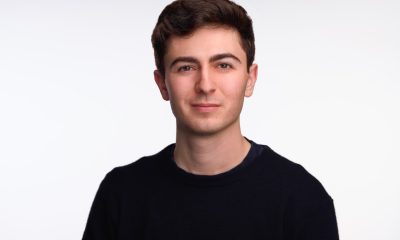Interviews
Evan Shapiro, CEO & Co-Founder of O(1) Labs – Interview Series

Evan Shapiro is the CEO & Co-Founder of O(1) Labs, the company responsible for launching Mina Protocol. Evan has a background in computer science, machine learning, distributed systems and robotics task planning.
What does O(1) refer to?
O(1) Labs is the company that my co-founder, Izaak Meckler, and I started back in 2017 to research and solve the centralization and data security issues behind blockchains. The team we built at O(1) Labs ended up incubating a consistent-sized blockchain, Mina Protocol, to address this problem.
O(1) refers to a concept in algorithmic complexity theory, Big-O notation, that describes how long an algorithm will take as a function of their input. O(1) notation is an algorithm that will always execute in the same time (or space) regardless of the size of the input data set, while others can be O(n), O(logn), etc. So no matter the size of the data, the time it takes to perform the algorithm stays the same. This is the property we get with Mina’s succinct blockchain – no matter how many transactions the chain has processed or how old the chain is, the blockchain takes constant time to verify. Hence the name, O-of-1 Labs.
Could you share with us the genesis story of O(1) Labs?
I started programming in high school, and so when I heard about cryptocurrencies, I was fascinated by their potential to transform the Internet. I read almost every white paper that was published in the early days of crypto. Fellow co-founder Izaak Meckler and I began to recognize holes in the design of legacy blockchains like Bitcoin and later Ethereum boiled down to one root problem: the design of these blockchains meant they would eventually become too data-heavy for inclusive participation by mining and validating nodes. This would impact decentralization and security. Fellow co-founder Izaak and I created O(1) Labs to address this root problem, and Mina is the solution that emerged from years of research, development, and testing.
In 2017, O(1) Labs launched the Mina blockchain (formerly named Coda Protocol), why did you believe it was the right time to launch a new blockchain?
For us, it wasn't about finding “the right time,” but rather solving a key technical challenge in the cryptocurrency space, and optimizing for launching the testnet when it was ready for the community to participate and provide feedback. We spent many months collecting and acting on user feedback before launching mainnet on March 23rd 2021. Shortly after, the Mina community token sale completed, raising $18.75M in 4 hours.
Mina is a lightweight blockchain that is only 22kb in size. What are the benefits of keeping a blockchain small?
Nodes must download the entire chain in order to participate in consensus. Legacy blockchains like Bitcoin and Ethereum have become incredibly data-heavy and so nodes must meet certain resource requirements in order to participate (for context, the Bitcoin blockchain is currently about 349 GB, while Mina remains 22kb). These high computing requirements limit the eligible pool of consensus nodes, which impacts the network's level of decentralization, and, ultimately, security. By encompassing the entire state of the chain in a single, light-weight zero-knowledge proof, Mina is much easier to download, which expands the pool of eligible nodes, increasing accessibility and decentralization.
Could you explain what Zero-knowledge Proofs are specifically?
In its essence, a zero knowledge proof allows the sender to prove a fact is true without sharing the fact itself. This makes zero knowledge proofs ideal for proving that the sender has access to private information without disclosing the private information itself. Mina deploys recursive zk-SNARKs, which capture the state of the entire blockchain as a lightweight snapshot instead of the chain itself. When the next block in the network is created, it takes a snapshot of itself — with the snapshot of the previous state of the blockchain as the background. That new snapshot will in turn be used as the backdrop for the next block, and so on and so on – this is the “recursive” part. Incredibly, while it can contain proof of an infinite amount of information, the snapshot always remains the same size.
Outside of the blockchain size, what else differentiates Mina from competing blockchains?
Mina's deployment of recursive zk-SNARKs enables developers to create verifiable applications that give users control over what data they'd like to share. By not requiring users to share sensitive information, these applications—called Snapps—protect user data from being vulnerable to hacks and breaches. If Snapps were leveraged across the web, the internet would be a much safer and more private place for users.
Could you elaborate on what Snapps are?
Snapps are verifiable applications created using the Mina protocol. One example of a Snapp is the decentralized lending protocol Teller Finance, which leverages Mina to enable users to prove that their credit score is above 700 without sharing the actual score or other sensitive personally identifiable information (PII) like their social security number with the requesting party. Mina connects to a credit score reporting agency, produces a proof (e.g., passing the credit threshold), and shares that proof with the requesting party. By sharing a proof rather than the actual data, Teller Finance never puts users' PII in jeopardy.
What is the Mina blockchain team currently working on?
We're excited to bring the personal data privacy-preserving capabilities of Mina to additional blockchains and are working on creating bridges to other chains. We also have a fantastic and highly-engaged global community.
Is there anything else you would like to share about O(1) Labs or Mina?
To stay up-to-date on our latest developments and participate in our global community, check out our website and social and community channels:
Discord: https://bit.ly/MinaDiscord
Telegram: http://bit.ly/MinaTelegram
Twitter: https://twitter.com/MinaProtocol
Medium: https://medium.com/MinaProtocol
YouTube: https://youtube.com/c/MinaProtocol
Thank you for the great interview, readers who wish to learn more should visit O(1) Labs, and/or Mina Protocol.












